Chapter 7
Something Special
Since the early sixties, one could expect to see most if not all current in-service aircraft types of the RAF represented in any ‘At Home’ flying programme, at least once in any given format; i.e. as a formation flypast, a solo display or a role demonstration, depending on resources versus demand. Furthermore, the presence of a centre-piece jet aerobatics team became the principal item on all flying displays.
Any shortfall in RAF participation in the flying could always be beefed up with contemporary military aircraft from other services such as the Royal Navy or a foreign air force, a luxury not available to the ‘At Home’ stations of the early post-war years. As far back as the earliest Battle of Britain displays, however, imagination was always demonstrated in the flying display content. At Odiham in 1954, a demonstration by two Royal Navy Sea Furies of take-off with rocket assistance was billed. Most displays would include some set-piece or other involving certain scenarios, such as the proverbial attacks on mock targets, sometimes along the lines of something topical like a Mau Mau stronghold, as was the case in 1953 at Oakington.
Elsewhere, flying displays regularly fielded items which took advantage of the station’s role, and as such in some cases became particularly popular destinations with the connoisseur aviation enthusiasts with a certain interest in a certain aircraft who went out of their way to travel some distance away from a station nearer to home to be where they could have their fill of Vulcans or whatever. Among the examples which became regular features of the flying displays at some stations included Finningley and Waddington, which invariably planned a quick-reaction scramble of Vulcans; usually four of these aircraft would be involved. They would then either disperse to other ‘At Home’ stations, return to the parent unit or return to the host stations for a stream landing. It’s amazing how dramatic four ‘aeroplanes’ taking off can be.
Leuchars and Coltishall, being operational interceptor bases, could usually lay on a stream take-off of Lightnings, Javelins or Hunters which would return for either a formation flypast, formation aerobatics/air drill or run in to break and land. In 1957, Biggin Hill, still an operational fighter station at the time, along with Tangmere, each arranged a similar opening involving the respective Hunter wings to launch and set up tail chase, involving up to 24 aircraft around the field before disappearing to return in massed formation. In 1968, 1969 and 1970, Coltishall launched 16 Lightnings each time to return in diamond formation overhead. In 1968, this was the first time as many as 16 aircraft of this level of performance on the RAF’s inventory had been flown in close formation. The formation first flew that year at the Royal Air Force’s 50th Anniversary display held at Abingdon in June. That September, the formation was added to the programme for Coltishall’s ‘At Home’ display and flew over the City of Norwich on 15th September, the following Sunday.
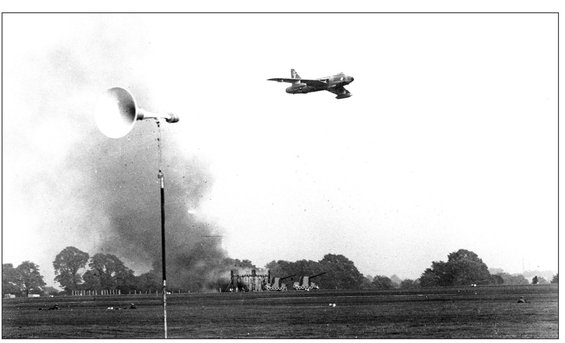
Tactical set pieces and other role demonstrations were once common place at RAF organised displays. Here a Hunter F6 of 229 OCU simulates a low-level strafing/rocket strike on dummy tanks at RAF Gaydon, 20th September 1969. This aircraft is one of 20 Hunters provided by the same unit for flying displays on that day. (Warwickshire County Records Office)
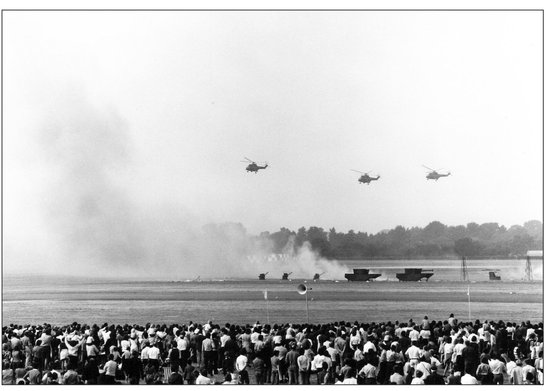
Pumas landing jeeps and artillery during tactical set pieces at Abingdon on 15 September 1973. (Crown Copyright)
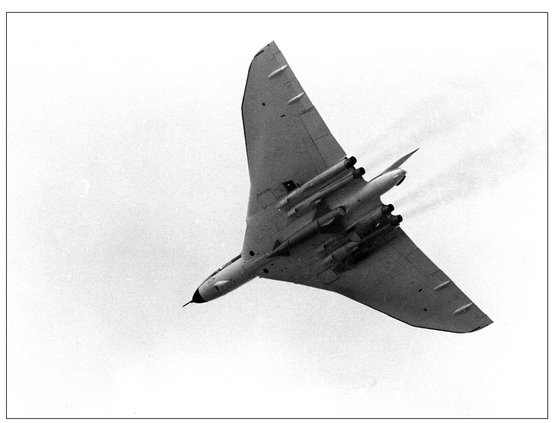
Vulcan B2 of 617 Squadron, off the Finningley scramble, carrying the Blue Steel practice round over Gaydon on 20th September 1969. (Warwickshire County Records)
With contributions from NATO air forces developing during this period. Overseas teams were now being recognised with star billing where there was little chance of attracting what was by now the premier home team, The Red Arrows.
The first foreign aerobatics teams to perform at British displays were from the United States Air Force in the early 1950s. The team which made the earliest appearance was, as referred to previously, the Skyblazers. Another US team, the Acrojets, flying T33s, were billed to display at Biggin Hill in 1955. After 1962, the UK teams were outnumbered at the Battle of Britain displays by the continental teams: in 1964, only three out of twelve ‘At Home’ stations had an RAF team on top billing; the rest were from overseas. It was at this time also that the RAF was changing from front-line operational aircraft to the less formidable machines of Flying Training Command to equip its aerobatics teams. The first Training Command teams were introduced in the 1950s when the flying training schools started receiving trainer versions of the early jet fighters, the Meteor and Vampire and subsequently the Jet Provost. In 1964 Training Command provided the two principal display teams representing the RAF with the Yellow Jacks from No. 4 FTS and the Red Pelicans from CFS. Fighter Command, nevertheless, continued to provide ad hoc teams of Lightnings and Hunters from various Squadrons for the Battle of Britain displays throughout the rest of the sixties.
The longest-running RAF aerobatics team and arguably the most prominent team in the public and media perception, the Red Arrows, were formed at the end of 1964 with seven Folland Gnat advanced jet trainer aircraft. Despite the rapid growth in popularity of The Red Arrows in their first couple of years, the truth is they had no permanent basis for existence as a unit in their own right until 1969. Before then they had existed on an ad hoc basis which was actually the same state of affairs as for all display teams prior. Much has been made in the press in recent times about attempts by the Government to disband the team on the grounds of unjustifiable expense, and some may feel justified in thinking this a typical sign of the times, i.e. a Government that doesn’t appreciate the prestige at home and abroad that The Red Arrows have come to symbolise. Whether that is the truth or not, the idea of fighting Treasury cuts aimed at the team is nothing new. Although such processes as resource account budgeting and private funding initiatives were unheard of in 1968 it didn’t mean that this was, or that there ever was, a time when the Treasury could be approached for funds and be expected to hand over whatever was required without trying at least to find a reason to object. Finding reason to object to funding a military display team has always been easy to do; finding the reasons to combat the negative is, far more difficult.
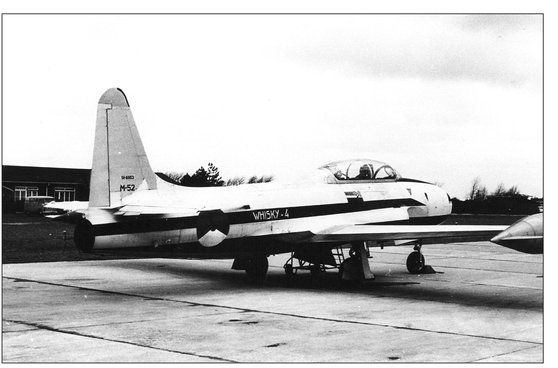
A Lockheed T33 Shooting Star of the Dutch team ‘Whisky Four’ circa 1966. The following year the team disbanded following an accident after changing to the more powerful F84F Thunder Streak (Sectie Luchtmacht Historie)
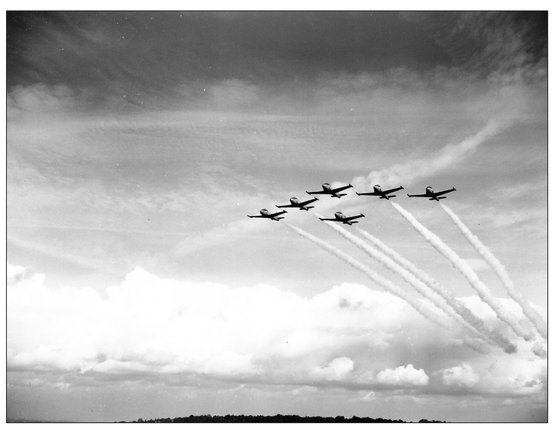
The Red Pelicans, who were perhaps the pre-eminent Jet Provost team during rehearsals over Biggin Hill, September 1963. The team’s colour at this time was Dayglo Red and they were fitted with colour smoke generators. (Crown Copyright)
After an almost hand-to-mouth existence from 1965 to 1968 during which the team’s future was reviewed at the end of each year and proposals made for the following year with estimated costs, a more permanent unit identity was sought in order to avoid an uncertain future and ensure continuity of experience and training. The Inspector General of the RAF, Air Marshal Sir Reginald Emson, was called upon to make the case for a six-year permanent unit establishment; if this was not accepted the chances were that the team might have flown their last display at the end of 1968, the Golden Anniversary year of the RAF.
To be stood up as a permanent unit would ensure the team’s existence until the end of 1974, when they would be reviewed again.
There were arguments put forward for taking the risk of continuing on the ad hoc basis, chiefly that there were hidden costs that could be discounted in making personnel available from other units which bore such costs. If the team were to be set up on a more permanent basis, then these costs probably could not be discounted any longer. Further reservations were the level of events that the team had attended, which included a fairly high proportion of minor events. Assuming the major events had been covered, this prompted the suggestion that overuse of the team would lessen their impact (the Inspector General’s report recommended expanding the team’s activities) and was something to be mindful of when making recommendations to the Treasury. Despite this, the team had turned down many events, typically 20 or more each year, among which were some quite prestigious ones including the famous Koksijde Air Show in Belgium which had their bid turned down in 1966 and 1967. However, as history knows, The Red Arrows got their six-year establishment. In a letter from the Treasury in January 1969, the Air Force Board’s recommendation to accept the Inspector General’s proposal to place the team on a permanent footing for the period stated had been accepted. It had also been taken into consideration that provision for the team had already been made for 1969/70 and that it was expected to find room for costs within standing financial allocations over the remaining years.
As far as getting the RAF’s premier team, as they had become, to the RAF’s premier events each September was concerned, the priority was Biggin Hill and one other station in the southern region, either Abingdon or Benson. 1970 was the first year that The Red Arrows were sent elsewhere than Biggin Hill, being allocated that year for the first time to Coltishall and Finningley. 1974, with only four events spread over two dates in September, afforded an opportunity for the team to appear for the first time at all of the designated Battle of Britain displays for that year. The display at Finningley was moved to the week after to avoid a clash with the nearby Doncaster St Leger. By doing this the team were allowed to attend three events, the display-flying maximum for one day, on the 14th and Finningley on the 21st. However, at the beginning of 1974 another oil crisis brought about fuel restrictions the result of which forced the RAF to implement the prohibition of all display flying. This was lifted to a degree early on to allow bids for display teams and solo displays including fixed-wing types from 1st June. A report at the time stated that most display teams and solo displays could be worked up and perfected in a relatively short time. The Red Arrows, however, would require a period of several months. A compromise was suggested to allow the team to work up a reduced display sequence but on the other hand it had to be of a standard which would not compromise the standards which had been reached over the years. A further problem was that that year the team had a new leader. Another victim of the oil crisis was the hitherto plethora of Jet Provost aerobatics teams. In 1973 five teams were authorised and made possible from surplus instructors. In 1974 just one team, the Swords, was authorised.
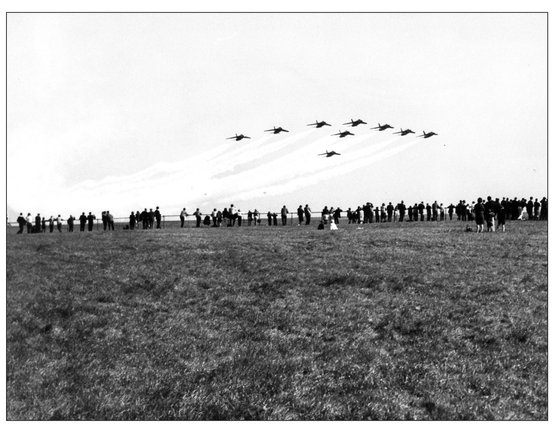
Nine Follands Gnats of the Red Arows running over Biggin Hill on 17th September 1966. (National Archives)
The more familiar Poachers of the RAF College Cranwell were resurrected in 1975 and again in 1976; hereafter The Red Arrows have been the sole fixed-wing jet aerobatics team fielded by the RAF each year.
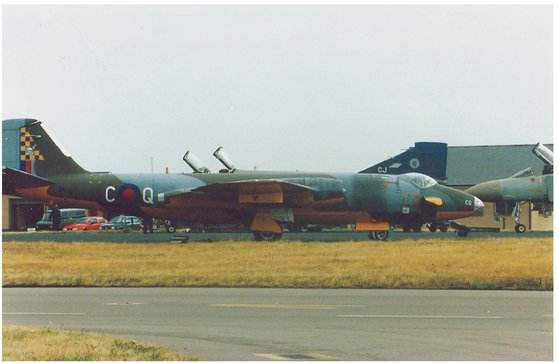
On the flight line at Finningley on 22 September 1990, the year of the 50th anniversary of the Battle of Britain stands a 100 Squadron Canberra. 228 OCU Phantoms can be seen in the background. All are solo display mounts with spares on hand, a routine provision now for many years. (Author’s Collection)
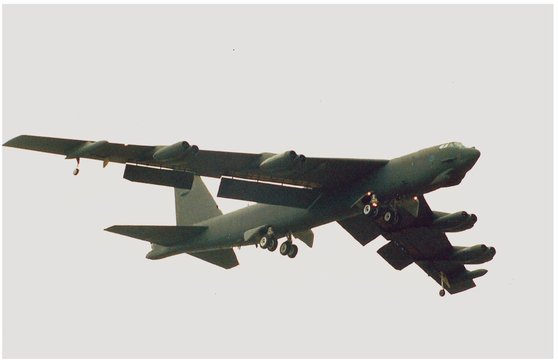
A Boeing B52G Stratofortress at Boscombe Down on the occasion of the RAF Benevolent Fund Enterprises 50th Anniversary Battle of Britain Air Show on the weekend of 9 and 10 June 1990. (Author’s Collection)
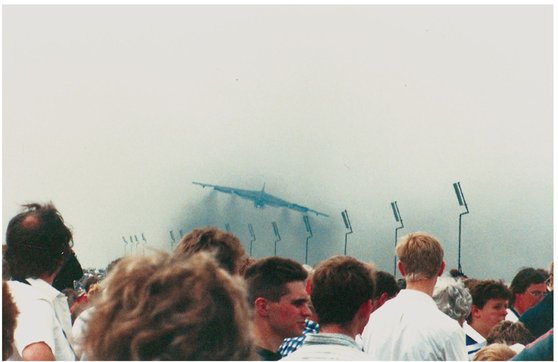
Clean your act up! Boeing B52G Stratofortress getting airborne at Boscombe Down in June 1990. (Author’s Collection)
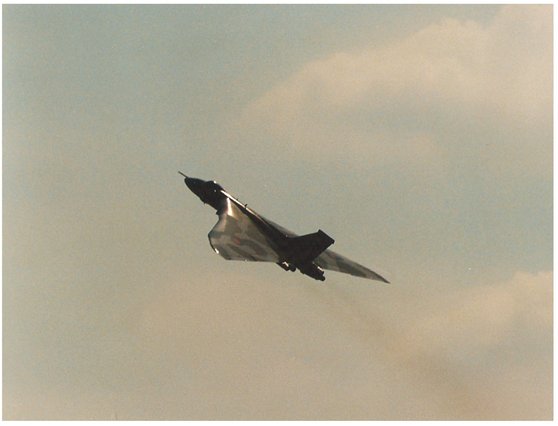
Vulcan B2 XH558 climbing steeply after takeoff from Mildenhall during May 1990. (Author’s Collection)

An F101C at Finningley on 19 September 1964. (John Wharam)
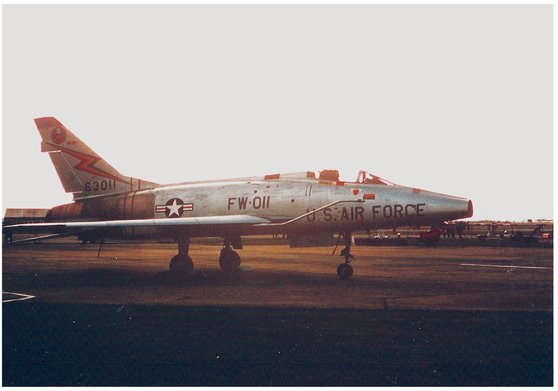
An F100 Super Sabre at Finningley on 19 September 1964. (John Wharam)
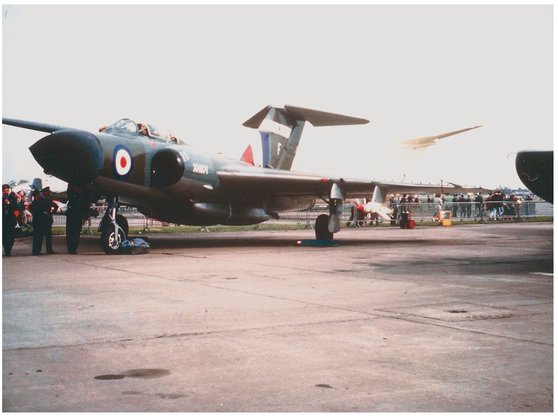
This Javelin is an FAW9R of 64 Squadron photographed at Finningley on 19 September 1964. (John Wharam)

The first appearance by F4s in the UK included this F4C of the USAF 81st Tactical Fighter Wing seen here in the static display at Finningley on 17 September 1966. (John Waram)

An Etendard IV of the French Navy at Biggin Hill on 20 September 1975. This aircraft gave a rare display here this day. In the background can be seen two Dutch F104Gs, display aircraft and spare. (Keith Butcher)
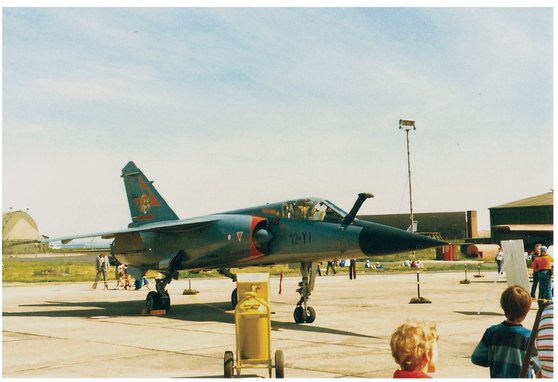
This French Mirage F1C has been seen on numerous occasions at RAF displays at Waddington and Leuchars and elsewhere as a one of a pair known as ‘Voltege Victor’. Seen here at Bitburg in Germany 1981. (Author’s Collection)
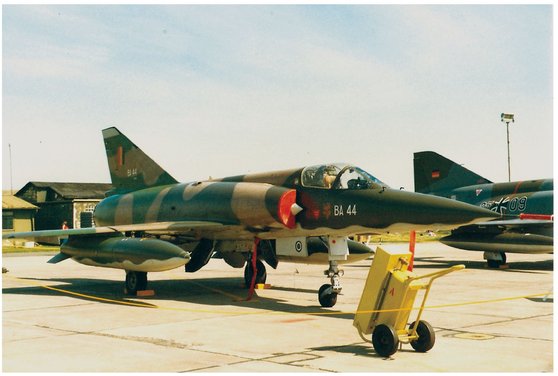
Belgian Air Force Mirage 5BA, BA44. (Author’s Collection)
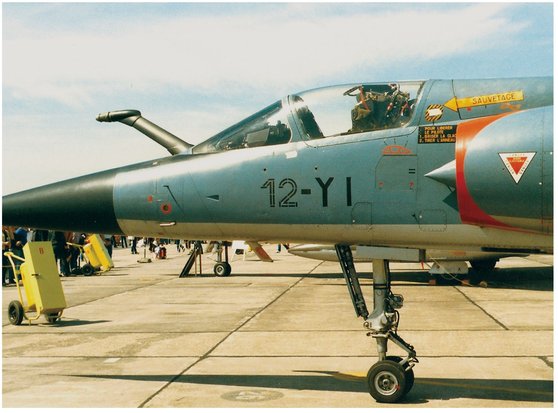
French Mirage F1C seen at Bitburg in June 1981 during the Open House, known locally as ‘Flug Tag’. (Author’s Collection)

An F5E Tiger II of the USAF 527th Aggressor Squadron on a miserable day at Finningley, 20 September 1980. This uprated version of the Freedom Fighter has appeared at the Waddington International Air Show in the hands of Patrouille Suisse in 1997 and 1999 who are also regular performers at the RIAT. (John Fisher)
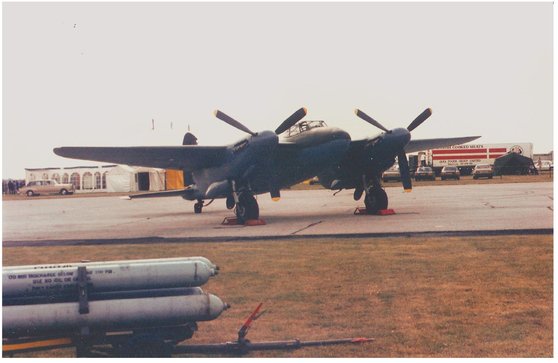
Until it was lost in a tragic accident at Manchester in 1996, de Havilland Mosquito T3, HT-E was the sole airworthy example of this type and is seen here on the flight line at Finningley circa 1981. (John Fisher)
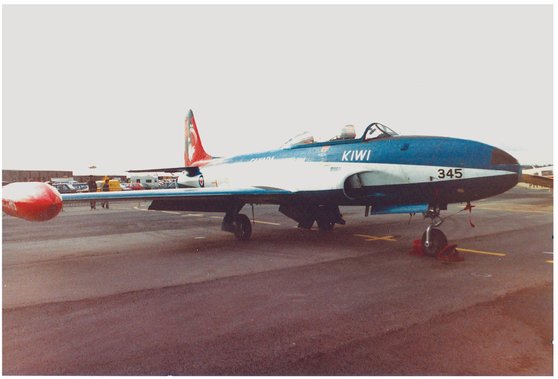
Lockheed T-33 Shooting Star, 133345 of the Royal Canadian Armed Forces, at Finningley on 17 September 1983. During the 1980s CT33s of the RCAF were regular visitors to Finningley. (John Fisher)

A line up of warbirds at Finningley circa 1984, with Lancaster, Hurricane, Mosquito and B17. (John Fisher)
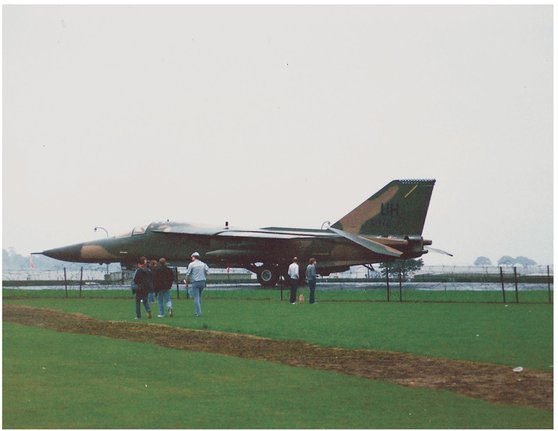
An F111E of the 55th TFW USAF on the Binbrook Flight Line on 22 August 1987. (John Fisher)
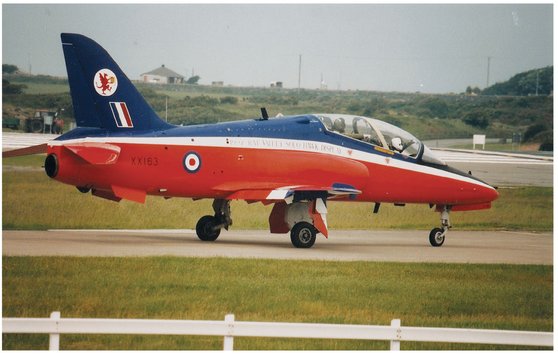
Solo Display Hawk, from No. 4 Flying Training School RAF Valley in the paint scheme adopted from 1988 with the Blue spine. (John Fisher)
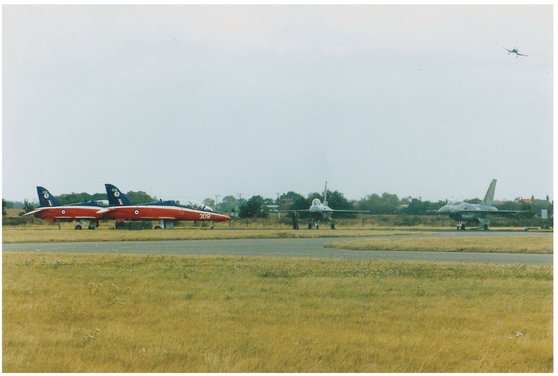
Part of the flight line at Finningley on 22 September 1990, the year of the 50th anniversary of the Battle of Britain. Belgian F16s with 2 FTS Hawks and what looks like an F4U Corsair on finals in the background. (Author’s Collection)

Hawks of the Red Arrows at Finningley circa 1985, carrying out ‘The Boomerang’ manoeuvre (dropped from the display sequence after 1988). This manoeuvre, as can be seen, culminates with the two aircraft of the synchro pair on converging paths which meet just before the crowd line. Note the oncoming Hawk has his airbrake extended, it being the responsibility of one pilot to miss the other. (John Fisher)
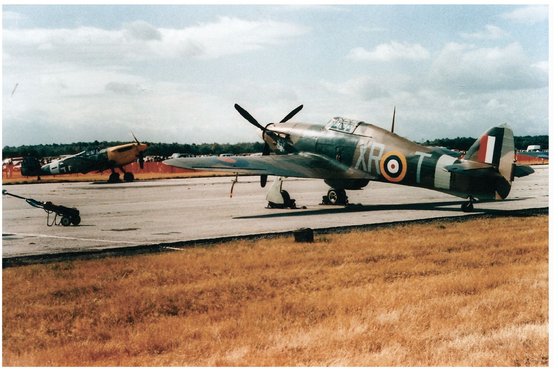
Hawker Hurricane with a Bf 109 in the background. Battle of Britain 50th anniversary, 22 September 1990. (Author’s Collection)
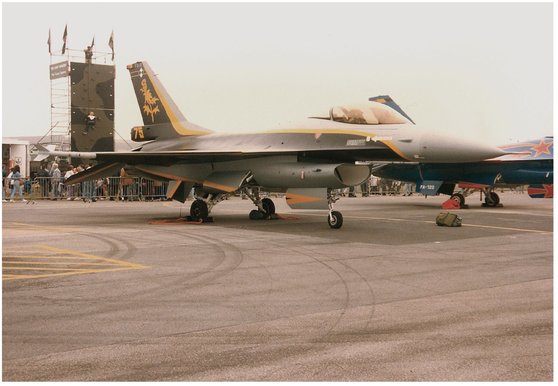
A specially marked F16 of the Belgian Air Force marking the unit’s 75th Anniversary. An even more outlandishly painted F16, also from the Belgian Air Force can be seen in the background here at Finningley on 19 September 1992. (John Fisher)
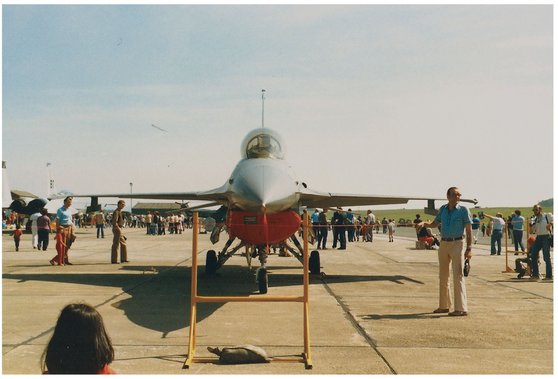
An early public appearance by Belgian F16 in June 1981, on this occasion at the US Air Force Open House at Bitburg in West Germany. (Author’s Collection)

F15C from the 57th Interceptor Squadron USAF seen on the static line up at Finningley, 19 September 1992. (John Fisher)

This formation of three Varsities is seen here flying past at Finningley on 19 September 1964. This formation; WF425, WJ919 and WL683 (seen in the centre) also flew over Biggin Hill, Coltishall and Waddington and were one of three such touring formations on that day. (John Wharam)
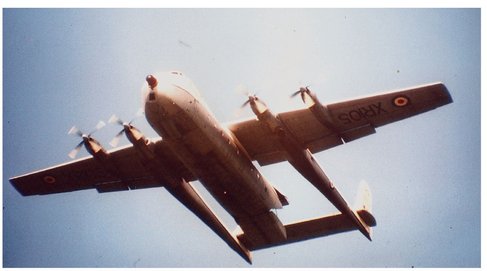
A single Argosy, XR105, is seen overhead Church Fenton in June 1965. (John Wharam)
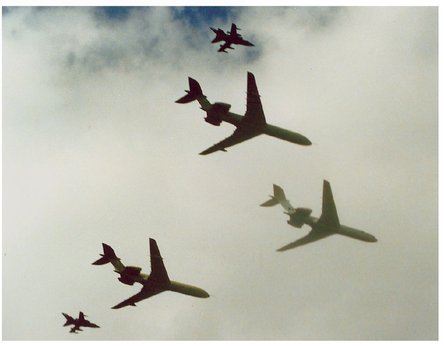
VC10s both tanker and transport variants together with Tornado GR1As of 13 Squadron over flying Abingdon on the occasion of the 50th Anniversary of the Battle of Britain on 15 September 1990. (Author’s Collection)

VC10 XV101 in a slow pass over Abingdon on 15 September 1979. (Keith Butcher)
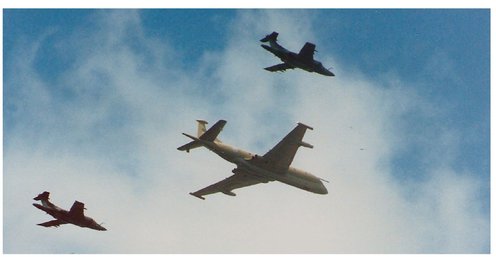
Nimrod MR2 flypast in company with Buccaneers over Abingdon on 15 September 1990. (Author’s Collection)

Wessex taking part in tactical set piece display at Finningley on 19 September 1964. Note the dummy fort in the back ground which on this occasion was strafed by four Hunter F6s from AFDS and then bombed by a Vulcan of the home based OCU. (John Wharam)
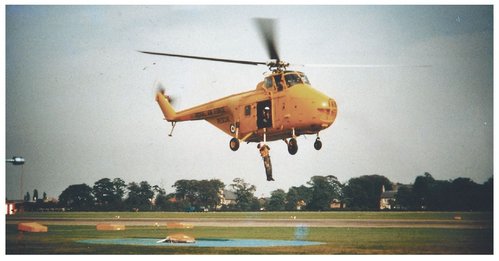
A Whirlwind demonstrating air sea rescue procedures at Finningley on 14 September 1963. (John Wharam)
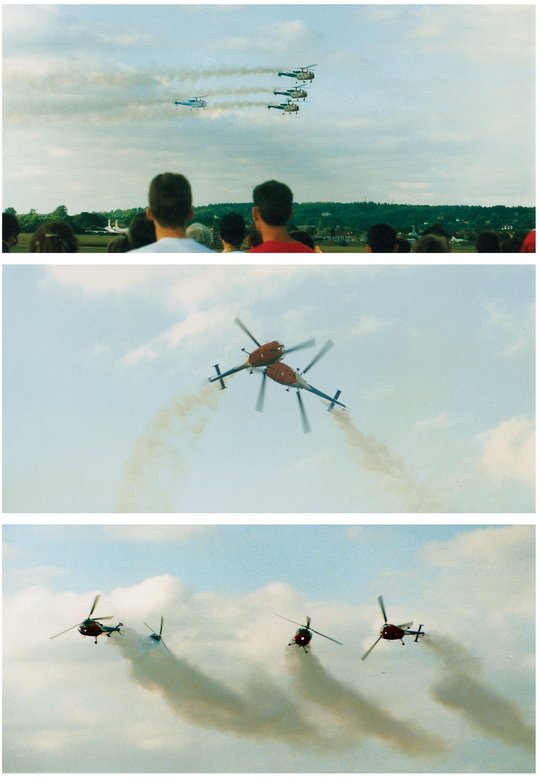
A series of photographs showing four Allouette Helicopters of the now disbanded Grass Hoppers display team from the Royal Netherlands Air Force at Abingdon on 15 September 1990.
(Author’s Collection)